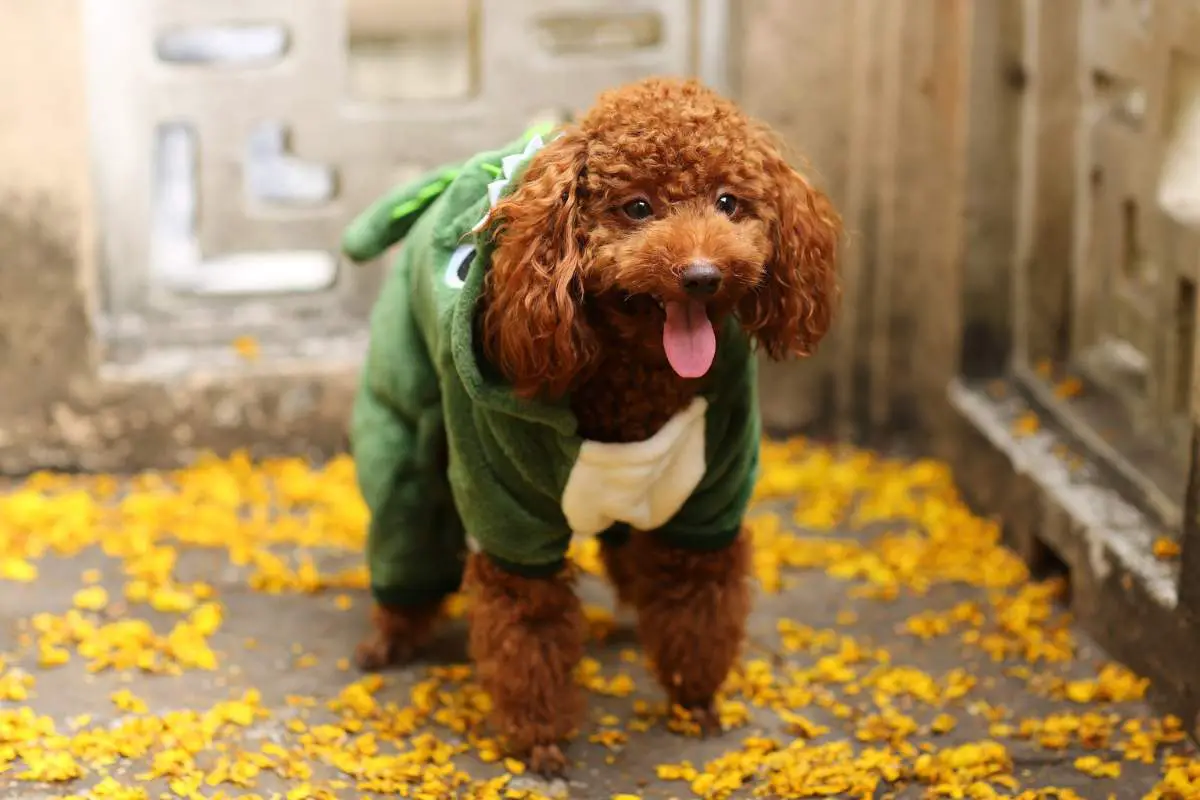In a world full of dogs with their own Instagram accounts, putting clothes on pets is a popular trend right now. If you’re one of those people who wants to see your dog all dressed up, read on to find out why they’re freezing up and how to fix it.
So, why do dogs freeze when wearing clothes? There are many reasons why your dog might freeze up when you put clothes on them. First of all, unlike people, dogs aren’t used to wearing clothes. Clothes cover much more of their body than they’re used to. They don’t know what else to do, so they freeze up from their discomfort.
If you want to learn more about why your dog freezes on the spot, we’ll first go over some safety concerns, solutions to this behavior, and general advice for dressing up your dog.
Why Do We Like Putting Clothes on Our Pets?

It’s probably self-explanatory but human beings have a soft spot for anything “cute.” We tend to like animals more when they’re small. A dog the size of a whale would be terrifying, but a small dog that you can fit in your purse is adorable. Having our pets do the things we do is even better, such as wearing clothes. Some people will even go as far to cook their pets gourmet food.
In this day and age, we treat pets like we would babies. There’s been a recent trend in “dog moms” or “dog dads,” where people treat their pets like family. In doing so, we also want to give them the privileges that we have, even if they don’t understand it.
Or maybe we just think they look funny wearing a potato costume for Halloween. Either way, this is why it’s fairly common to see a dog in a sweater, whether the dog likes it or not.
Why Does My Dog Freeze?
There are many reasons why your dog might freeze up when you put clothes on them. First of all, unlike people, dogs aren’t used to wearing clothes. Clothes cover much more of their body than they’re used to.
If your dog freezes when wearing clothes, it may be because, although dogs love being pets, they’re not accustomed to being touched all over at the same time. This can lead to over-stimulation, and they may not be sure how to react, simply hoping that by acting strangely enough, you’ll stop.
The material of the clothing can also play a role. Certain fabrics are gentler on their fur while others are not. For example, 100% cotton is the material most dog clothes are made out of because of how breathable the material is. Simply changing the material could make your dog more open to wearing clothes.
Things to Think About
While there are many breeds of dogs that could benefit from wearing clothes, a different breed might have negative consequences from the same clothing.
For example, terriers have a thick coat of fur that sheds water to allow them to be outside, even in damp weather. That small extra layer of clothing could be very uncomfortable and even harmful if the owner isn’t informed about these consequences.
However, if you’re determined to have your dog wear clothing, make sure you do your research on what your dog needs and doesn’t need. Here’s some things to think about:
- How thick is my dog’s fur coat?
- How old is my dog?
- What breed is my dog?
- Is my dog big or small?
- What is the climate like where I live?
- Does my dog have any known allergies?
These are all questions you need to ask yourself before you think about buying clothes for your dog. In fact, some of these questions could be answered by your local vet, which we encourage you to talk to for any concern you might have. After all, your veterinarian has a more detailed medical history on your pets than we do.
How Thick is My Dog’s Fur Coat?

It’s common knowledge that dogs, like cats, have a thin or thick layer of fur coating their entire body. Most dogs do not need clothing to protect themselves from harsher climates. In fact, by subjecting your dog to thick clothing while they also have thick fur, you’re causing harm. It might look cute, but a happy dog is even cuter.
However, if your dog has a thin layer of fur and the climate is colder, then giving them a sweater or coat would actually be helpful. This mostly applies for going outside, as having them wear sweaters inside might be a bit overkill. Dogs only have sweat glands on the bottom of their feet, so they could overheat if your home is warm and they’re wearing thick clothing.
How Old Is My Dog?
If your dog is a puppy or even in the older age bracket, then clothing might also be functional as well as fashionable. Puppies and older dogs need a little extra protection, especially in harsher climates.
Older dogs are also more prone to certain conditions like arthritis, or a weaker immune system that would require thick clothing. Alongside that, as dogs age, their heat regulation declines. Even a dog with a thick coat could require clothing in the winter. So, if your older dog still likes going on walks, having thick clothing is an absolute must to keep them warm.
However, if your older dog is sick or has conditions like arthritis, it might simply be better for your dog to stay inside, rather than having to put clothing on in harsh weather.
Younger dogs also have a lot of built-up energy. Depending on the breed, long walks might not be enough to completely tire them out. Thick clothing isn’t the only thing your dog can wear; if your dog has the need for it, think of introducing a backpack that adds a little extra weight. Of course, have patience and introduce the weight slowly over time for your dog’s health.
What is the Climate Like Where I Live?
If you live in a harsh, almost wintry climate, any addition of clothes in your dog’s life could be helpful. For example, if your dog has a lot of energy and loves walks, consider introducing boots to protect their paw pads from ice-melting salt. Without proper gear in a harsh climate, your dog might experience pain or even damage their paws over time.
Just like we talked about in the “How Thick is My Dog’s Fur?” section, dogs in harsher climates may require a coat, jacket, or even sweater, depending on how thick their fur is. Though, if the climate is incredibly harsh, like during a blizzard, maybe staying inside is a better idea.
Does My Dog Have Allergies?
Allergies are definitely something to think about when buying clothes for your dog. It could be as simple as your dog being allergic to a common fabric used to make most clothes, limiting your options. Or maybe your dog has a skin allergy and scratches their skin obsessively.
In this condition, clothing might be a necessary addition to your dog’s lifestyle. Buying baby socks to cover their paws or any other knitted material could be helpful and improve the condition of their skin. This wouldn’t leave them as open to serious infections.
How to Change Their Behavior?

Before we answer this question, let’s first ask why you want their behavior changed. If your dog is on the smaller size and lacks a thick winter coat like some large dogs, wearing dog clothes can not only be fashionable but functional. However, if you have a dog that doesn’t need that extra layer, maybe a different type of clothing would be a better idea.
Just like with any big life changes, introducing clothes into your dog’s life should start off small. Start off by maybe putting a single sock on one of their feet, or simply a light jacket. If they react well, that’s a good sign they might react well to larger pieces of clothing.
Why Does My Dog Not Move When I Put a Sweater on Him?
When a dog refuses to move or freezes when a sweater is put on him, it could be attributed to various reasons rooted in the animal’s instincts and preferences. One plausible explanation is that dogs are not inherently accustomed to wearing clothing. The sensation of fabric covering their bodies can be unfamiliar and uncomfortable, triggering a freeze response.
Additionally, certain dogs may perceive the act of putting on a sweater as an unexpected touch or handling, causing them to react by remaining still. Pet owners must observe their dog’s body language and respect their comfort levels when introducing clothing, considering factors such as material and fit to ensure a positive experience for the furry companion.
Conclusion
As we explained in this article, there are many factors that go into why your dog should and shouldn’t wear clothes. It’s definitely adorable to see dogs wearing a ballerina tutu on Instagram, but you should consider those dogs are most likely not wearing those clothes for long.
Finally, if you respect your dog’s personal boundaries and needs, you’ll easily be able to decide whether dog clothes are the right thing for them. If you have further questions, always make sure to reach out to your local vet, as they’re more than happy to answer questions for your pet’s health. They also have a deeper understanding of your dog’s health concerns and can give more specific recommendations.


